Myogenic Trismus Home Care Instructions
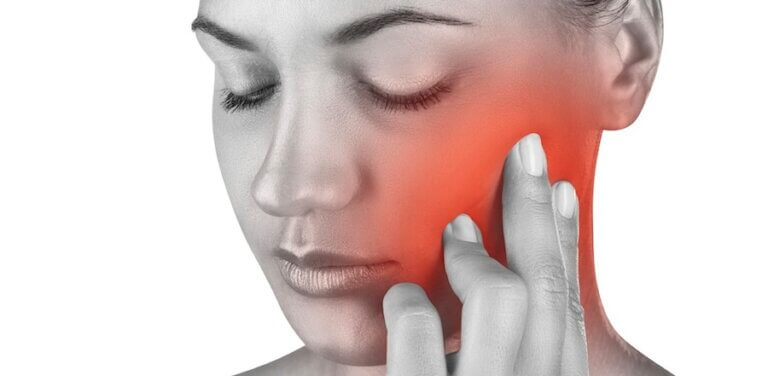
What Is Trismus?
When your jaw muscles become so tight that you have difficulty opening your mouth wide, you may have a condition known as trismus. Normally, your mouth opening measures 40-60 millimeters. If you have trismus, you may not be able to open your mouth wider than 20-35 millimeters.
When trismus occurs immediately after a visit to the dentist involving local anesthetic injections, it is called “myogenic trismus secondary to dental local anaesthesia.” It is a temporary side effect due to needle injury of the jaw muscles, resulting in inflammation and spasming of the jaw muscle. Such cases of trismus are the most common cause of jaw discomfort after dental procedures and is a known risk of local anesthetic. Healthcare providers treat such cases of myogenic trismus with medication and physical therapy.
Before seeking professional help from your dentist, there are some thing you should know as a patient:
- Normal Jaw Function
- Causes of Trismus
- Signs And Symptoms of Trismus
- Diagnosis of Trismus
- Treatment of Trismus
- Prognosis of Trismus
If you have further questions and concerns about trismus, please contact us.
Normal Jaw Function
Your jaw is made up of a pair of bones. These bones form the framework of your mouth and teeth:
- Your maxilla is your upper jawbone.
- Your mandible is your lower jawbone.
- Your temporomandibular joint (TMJ) is where your mandible connects to your skull.
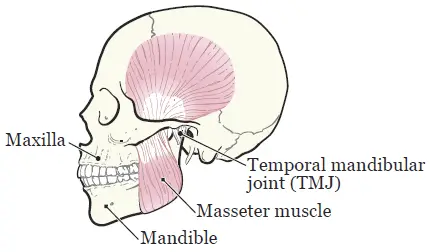
Many muscles around the jaw work together for you to open and close your mouth. The muscles responsible for mouth opening and chewing include the masseter muscle and temporalis muscle laterally, and the lateral pterygoid muscle and medial pterygoid muscle medially.
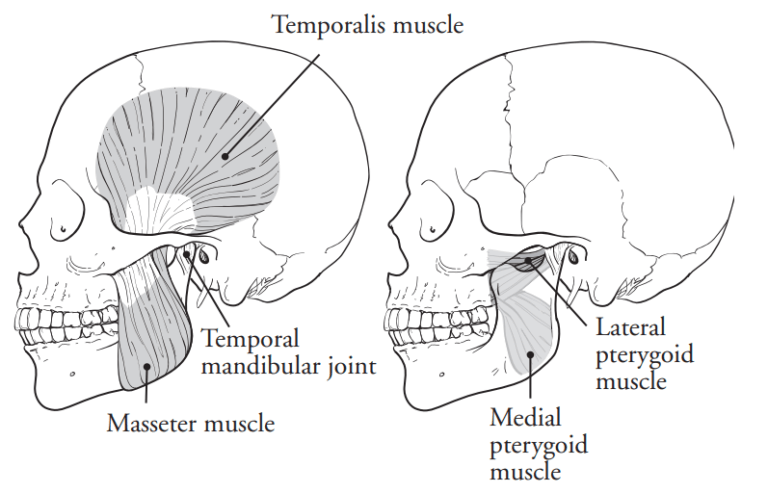
Causes Of Myogenic Trismus
Since trismus has been defined as a restriction in mouth opening regardless of etiology, trismus is linked to a long list of other medical conditions with similar presentations. The most common include:
- Dental Trauma: You may develop trismus if your jaw is hit or injured, such as the case of local anesthetic injections into the jaw muscle.
- Inflammatory conditions: You may develop trismus if you have rheumatoid arthritis, osteoarthritis and scleroderma. These conditions affect your temporomandibular joint and may cause trismus.
- Infections: Diseases like mumps and tonsillitis can trigger trismus. You may develop trismus if you have infections that affect your teeth, neck or parotid (salivary) gland. Tetanus (lockjaw) is a bacterial infection that may cause muscle spasms throughout your body.
- Peritonsillar abscess (PTA): Some people with tonsillitis develop peritonsillar abscesses — pus-filled pockets that form near your tonsils. People with PTA may develop trismus.
In the context of trismus occurring immediately after a dental appointment with local anesthesia, the trismus is caused by traumatic injury, inflammation and spasming of the muscles of mastication.
Signs And Symptoms Of Myogenic Trismus
The most common signs of trismus include:
- Limited mouth-opening ability; normally your mouth opening measures 40-60 millimeters (approximately the width of 3 fingers). If you have trismus, you may not be able to open your mouth wider than 20-35 millimeters
- Deviation of the jaw toward the affected side (muscles not functioning properly because of spasms)
- Diffuse facial swelling and fever (only if associated with infections)
The most common symptoms of trismus include:
- Pain at rest
- Difficulty to open the mouth wide and attain full-range motion
- Inability to chew or bite on solid foods
- Discomfort when yawning
- Difficulty to brush teeth and follow routine oral hygiene care, which can lead to bad breath and a high risk of caries
- Pain in one or more masticatory muscles
- Sensation of muscle tightness, cramping, or stiffness
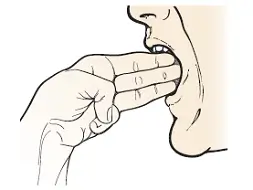
Diagnosis Of Myogenic Trismus
Healthcare providers diagnose trismus by asking about your symptoms and examining your jaw, neck and temporomandibular joint. If the trismus develops immediately after a dental appointment involving local anesthetic injections into the jaw, the dentist will quickly arrive at a diagnosis of “myogenic trismus secondary to dental local anaesthesia.”
Healthcare providers may do imaging tests, including computed tomography (CT) scans or magnetic resonance imaging (MRI) scans.
Treatment Of Myogenic Trismus
Myogenic trismus secondary to dental local anesthesia is treated with medications and physical therapy:
Pain Medication
- Robax Platinum is a combination muscle relaxant and pain reliever medication containing 500mg methocarbanol and ibuprofen 200mg indicated for effective relief of muscle spasm pain. Take 1-2 tablets every 4-6 hours as needed.
- You are also welcome to use over the counter pain relievers such as ibuprofen (Advil) or acetaminophen (Tylenol). Ask your dentist what dosage is right for you, but if you do not have a pre-existing medical condition of allergies, 1000mg acetaminophen (Tylenol) with 600mg ibuprofen (Advil) every 4-6 hours or as needed is a very powerful combination.
Active range of motion and stretching exercises
Do these exercises 3 times every day. Hold your head still while doing them.
- Open your mouth as wide as you can, until you feel a gentle stretch but no pain. Hold this stretch for 10 seconds, then relax. Take 1 full breath between each repetition. Repeat this 5 times.
- Move your lower jaw to the left. Hold this stretch for 3 seconds, then relax. Take 1 full breath between each repetition. Repeat this 5 times.
- Move your lower jaw to the right. Hold this stretch for 3 seconds, then relax. Take 1 full breath between each repetition. Repeat this 5 times.
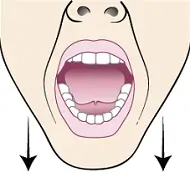
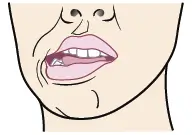
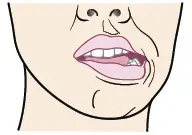
Passive stretching exercise
Do this exercise 3 times every day.
- Put on a pair of disposable medical gloves. If you do not have gloves, wash your hands well with soap and water. Wet your hands and apply soap. Rub your hands together well for at least 20 seconds, then rinse. Dry your hands with a paper towel and use that same towel to turn off the faucet. If you don’t have paper towels, it’s OK to use clean cloth towels. Replace them when they are wet.
- Place your thumb under your top front teeth.
- Place the index (pointer) finger of your other hand on your bottom front teeth.
- Open your mouth as wide as you can. Push your fingers gently against your teeth to give extra resistance. This will help to keep your mouth from closing. You should feel a gentle stretch, but no pain. Hold this stretch for 5 to 10 seconds, then relax. Take 1 full breath between each repetition. Repeat this 5 times.
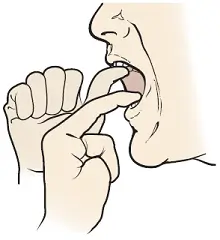
Additional Precautions and Interventions
- Rest your aching jaws: Everyday habits like biting your fingernails and chewing gum puts stress on your tight jaw muscles.
- Avoid solid foods: Substitute hard-to-chew food for soft foods or liquid meals.
- Try homemade heat therapy: Wrap a moist hot towel around your jaw and neck and leave it for 15 to 20 minutes once an hour. The moist heat will help your muscles relax and possibly reduce muscle spasms.
- Work with a physiotherapist to strengthen your jaw muscles, if needed.
If your trismus is due to reasons not related to myogenic injury from dental local anesthesia, consult your doctor or physician for diagnosis and treatment options.
Prognosis Of Myogenic Trismus
Myogenic trismus secondary to dental local anesthesia usually resolves itself in less than 4 to 6 weeks, but it can be very painful in the meantime. Permanent trismus can occur without medicinal or physical therapy intervention.

